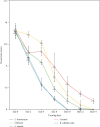Development and In Vivo Characterization of Probiotic Lysate-Treated Chitosan Nanogel as a Novel Biocompatible Formulation for Wound Healing
- PMID: 33778064
- PMCID: PMC7979291
- DOI: 10.1155/2020/8868618
Development and In Vivo Characterization of Probiotic Lysate-Treated Chitosan Nanogel as a Novel Biocompatible Formulation for Wound Healing
Abstract
Wound healing is a physiological reaction to tissue injuries which plays a crucial role in replacing the destroyed tissues. Probiotics produce valuable compounds that possess antibacterial and anti-inflammatory activities, immunomodulatory effects, and angiogenesis traits leading to the promotion of wound healing. Chitosan nanostructures have versatile properties making them quickly produced into gels, scaffolds, nanoparticles, beads, and sponge structures that can be incorporated into wound healing processes. In the current study, three formulations from nanogel consisting of probiotic supernatant (Lactobacillus reuteri, Lactobacillus fermentum, and Bacillus subtilis sp. natto)-loaded chitosan nanogels were prepared from the culture of corresponding cultures. The chitosan nanogels were previously characterized by Zetasizer, FTIR, and TEM. The prepared formulations' effectiveness and dressing activity were assessed by evaluating wound closure and histological trials in Sprague-Dawley rats. The results indicated that all probiotic lysate formulations have advantages over the wound healing process. However, Bacillus subtilis natto has a better wound healing quality, which is well known in pathology examination. The favorable effects of probiotic lysate nanogels, including the reasonable wound closing rate, good wound appearance, and satisfactory histological observation via in vivo examination, suggest it as a promising nominee for wound healing purposes.
Copyright © 2020 Yousef Ashoori et al.
Conflict of interest statement
The authors declare that there is not any conflict of interest.
Figures




Similar articles
-
Development of Interleukin-2 Loaded Chitosan-Based Nanogels Using Artificial Neural Networks and Investigating the Effects on Wound Healing in Rats.AAPS PharmSciTech. 2017 May;18(4):1019-1030. doi: 10.1208/s12249-016-0662-4. Epub 2016 Nov 16. AAPS PharmSciTech. 2017. PMID: 27853994
-
A Novel Effective Formulation of Bioactive Compounds for Wound Healing: Preparation, In Vivo Characterization, and Comparison of Various Postbiotics Cold Creams in a Rat Model.Evid Based Complement Alternat Med. 2021 Dec 7;2021:8577116. doi: 10.1155/2021/8577116. eCollection 2021. Evid Based Complement Alternat Med. 2021. PMID: 34917159 Free PMC article.
-
Lignin-Incorporated Nanogel Serving As an Antioxidant Biomaterial for Wound Healing.ACS Appl Bio Mater. 2021 Jan 18;4(1):3-13. doi: 10.1021/acsabm.0c00858. Epub 2020 Oct 1. ACS Appl Bio Mater. 2021. PMID: 35014273
-
Chitosan/Hyaluronic acid/Alginate and an assorted polymers loaded with honey, plant, and marine compounds for progressive wound healing-Know-how.Int J Biol Macromol. 2021 Sep 1;186:656-685. doi: 10.1016/j.ijbiomac.2021.07.067. Epub 2021 Jul 14. Int J Biol Macromol. 2021. PMID: 34271047 Review.
-
Chitosan-based structures for skin repair: A literature review.Int J Biol Macromol. 2025 May;306(Pt 2):141426. doi: 10.1016/j.ijbiomac.2025.141426. Epub 2025 Feb 25. Int J Biol Macromol. 2025. PMID: 40010450 Review.
Cited by
-
Chitosan alchemy: transforming tissue engineering and wound healing.RSC Adv. 2024 Jun 17;14(27):19219-19256. doi: 10.1039/d4ra01594k. eCollection 2024 Jun 12. RSC Adv. 2024. PMID: 38887635 Free PMC article. Review.
-
Postbiotic nanoparticles (postbiotics-NPs): a novel strategy for providing probiotics' health advantages through food consumption.Food Sci Biotechnol. 2024 Jun 23;33(12):2729-2736. doi: 10.1007/s10068-024-01629-6. eCollection 2024 Sep. Food Sci Biotechnol. 2024. PMID: 39184983 Free PMC article. Review.
-
The ameliorating effect of limosilactobacillus fermentum and its supernatant postbiotic on cisplatin-induced chronic kidney disease in an animal model.BMC Complement Med Ther. 2023 Jul 17;23(1):243. doi: 10.1186/s12906-023-04068-8. BMC Complement Med Ther. 2023. PMID: 37461012 Free PMC article.
-
Pharmacotechnical aspects of a stable probiotic formulation toward multidrug-resistance antibacterial activity: design and quality control.BMC Complement Med Ther. 2023 Oct 31;23(1):391. doi: 10.1186/s12906-023-04224-0. BMC Complement Med Ther. 2023. PMID: 37907893 Free PMC article.
-
A potential therapeutic strategy of an innovative probiotic formulation toward topical treatment of diabetic ulcer: an in vivo study.Nutr Diabetes. 2024 Aug 20;14(1):66. doi: 10.1038/s41387-024-00320-3. Nutr Diabetes. 2024. PMID: 39164243 Free PMC article.
References
-
- Mousavi S. M., Zarei M., Hashemi S. A., et al. Asymmetric membranes: a potential scaffold for wound healing applications. Symmetry. 2020;12(7)
-
- Nussbaum S. R., Carter M. J., Fife C. E., et al. An economic evaluation of the impact, cost, and medicare policy implications of chronic nonhealing wounds. Value in Health. 2018;21(1):27–32. - PubMed
MeSH terms
Substances
LinkOut - more resources
Full Text Sources
Molecular Biology Databases

